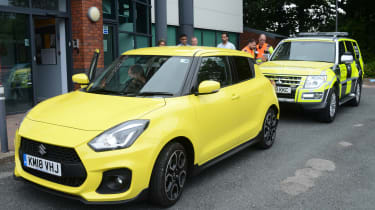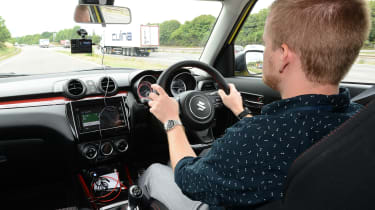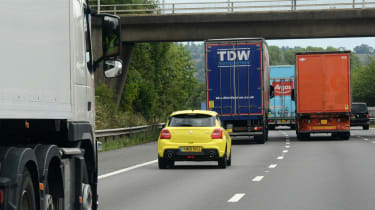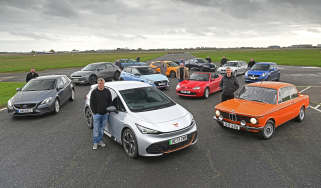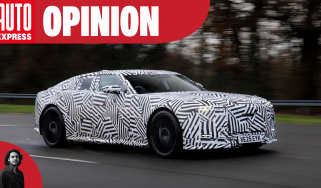What is tailgating? Definition, penalties and how to avoid it
Driving too close to the car in front can be dangerous. Here’s all you need to know about tailgating
Tailgating is a term used to describe the situation when a car drives closely behind another on a public road. It’s classed in the Highway Code as dangerous and careless driving, which means you can also be prosecuted for doing it.
How close is too close? Tailgating definition
There’s no official definition of tailgating beyond the fact that it’s simply driving too close to the car in front. Too close is contextual; at high speed being one car-length away would usually be considered far too close, yet in slow-moving traffic it’s perfectly acceptable in many places.
In reality, all drivers should know if they are tailgating as it’s part of understanding the Highway Code, which says: leave a gap large enough that you can stop safely if the car in front slows suddenly.
Highway code rule 126 states that “Tailgating is where the gap between you and the vehicle in front is too small for you to be able to stop safely if the vehicle in front suddenly brakes… [it is] dangerous, intimidating and can cause collisions, especially when driving at speed.”
What is the two-second rule?
An easy way to make sure you never tailgate another car is the two-second rule: look at a lamp-post or another roadside object as the car in front passes it. If you can count two seconds or more before you reach it, you’re all clear. As your driving instructor may well have told you, only a fool breaks the two-second rule.
When driving think of space, particularly distance to the car in front, as time to react. If something unexpected happens in front of you, the space you’ve allowed yourself is the time you have to stop or steer to avoid an accident. Generally speaking, the more of it you have the safer you’ll be.
Tailgating and stopping distances
Motorbikes and heavy vehicles like trucks need more time and distance to stop, so they should leave a longer gap to avoid tailgating. The Highway Code gives estimated stopping distances for cars and these also serve as a guide to how much space you should give other road users. The rule to remember is that stopping distances increase the faster that you travel, so you need a lot further to think, apply the brakes and stop at 70mph than at 50mph - almost double the distance.
What to do if someone is tailgating you
If someone else is tailgating you, there are a few things you can do depending on where you are driving. If you’re driving at slow to normal speeds, then slow down and leave a larger gap to the car in front. This will give you more room to slow down gently if needed, giving the car behind more chance to stop as well.
Getting angry at tailgaters will not solve anything, so try to relax and focus on your own driving. On roads with higher speed limits and motorways, you can slow down and let the tailgater overtake. On country roads, you can pull over into a side road or lay-by, or just slow down on a straight, well-sighted section to let them get past.
Once they overtake you, you no longer have to worry about them tailgating you and causing a crash. It’s up to the police to deal with them, so never try to stop them or brake check them as you could end up in a serious crash or confrontation.
Alternative definition of tailgating
The UK definition of tailgating, is driving too close to the car in front. In the US, the term tailgating regularly used to refer to the practice of having food and drinks out of the back of your car, often in the car park of an American football stadium in the build-up to the game. So if an American invites you to a tailgate or tailgating party, don’t assume they want you to join them for an afternoon of dangerous driving.
Does tailgating make you stressed?
In 2018, Auto Express was involved in a tailgating experiment to measure the impact of tailgating on driver stress levels. Read the feature below…
What’s the most annoying driving habit that you notice from day to day? Motorists on their mobile phone? Speeding outside schools? Or maybe middle-lane hogging? Well, according to detailed research by Highways England, it’s tailgating that irritates us the most.
The Government-owned company responsible for motorways and major trunk roads says almost nine out of 10 people have experienced tailgating, while over a quarter of drivers admit to having tailgated someone else.
But accident data indicates the practice is a real killer. One in eight road casualties is said to be a result of tailgating, which is linked to 100 deaths or serious injuries on our road network each year.
Then there are phantom traffic jams. These hold-ups appear to have no cause but are closely linked to tailgating, because constant braking and accelerating from motorists driving too close to the car in front creates a ‘caterpillar’ effect in traffic, slowing everyone down.
With so many issues related to this common yet dangerous habit, Highways England has conducted an extensive study into tailgating, and it invited Auto Express to the National Traffic Operations Centre (NTOC) west of Birmingham to find out what this research involved.
The study takes in data from hundreds of motorists. As different drivers will react to situations in different ways, participants were separated into categories, including those who consider themselves nervous or confident drivers, and those who drive on a professional basis.
The study consists of two elements; one is conducted on the road, while the other involves recorded examples of bad driving being shown on a computer screen.
First comes the practical part, and before the work starts, prep is needed on the Suzuki Swift Sport I’m running on the Auto Express fleet, and on me. A heart rate monitor is wrapped around my wrist to compare my resting heart rate relative to how it alters on the road, while the Swift is hooked up with a series of cameras – one facing forward, another backward and one pointing at my face.
The route we’re taking mainly comprises motorway driving: out of the NTOC centre, onto the M5, the M42, then turn around at Hopwood Park Services before retracing our steps. It’s a journey of about 28 miles and, traffic permitting, 45 minutes. I answer a brief questionnaire about how I’m feeling before heading out, picking a smiley face from the list of available emojis.
For the vast majority of my drive, everything seemed uneventful, to my eyes, at least. This was in part due to the quiet mid-afternoon motorway traffic, but was also a result of the traffic officer who was following me, keeping watch on my experiment and allowing our photographer to get shots. Of course, the full subjects of the study covered thousands of miles to my 28 and didn’t have the escort. I spent much of the journey wondering how relevant my data would be.
Just towards the end of my drive, however, the gantries above the M5 slip road indicated a 40mph speed limit due to stationary traffic ahead. I coasted down to this speed, much to the annoyance of a following Vauxhall Insignia, who closed right up behind me. Tailgating!
A second questionnaire about my on-road driving followed my return to base. Insignia incident aside, I didn’t recall anything that stressed me out in particular, so was interested to see the results of my heart rate monitor. This, as it turned out, brought up more instances of potential stress than I had expected.
Analysis showed two situations in particular caused spikes in my heart rate. The first was a lane change by a lorry, causing a speeding van to move into the outside lane. While this didn’t immediately affect me, my reaction was likely due to the realisation that I needed to consider moving not just one lane to overtake, but two.
The second situation arose when I was overtaking another lorry, and a van was overtaking me at the same time. Being surrounded by significantly larger vehicles is a regular occurrence for many road users, and this situation caused my heart rate to increase by 10 points, and remain raised for almost a minute after the incident.
Overall, my heart rate rose by the smallest amount on motorways, and most on the roundabouts leaving them. For those who are nervous or less experienced on motorways, these results would likely have been reversed.
Practical assessment over, it was now time to try the next part of the test from the comfort of an office chair.
This section involved watching two scenarios reminiscent of those in a hazard-perception exam. A facial tracker would assess my emotions during each scenario, and I would answer questions based on what I saw.
The first scenario was, in essence, a control test, as it showed no adverse driving at all. On the westbound M3 junction with the M25, a driver indicated, then calmly and safely moved over from the right-hand lane to the left. I was asked to convey my emotions at the manoeuvre, which were indifferent. The facial tracker corroborated my opinion, recording no obvious reaction.
The second scenario certainly prompted a response, though: another driver’s violent manoeuvre saw their car veer from lane three to one, swerving around the back of a lorry as it headed on to the slip road at the very last second, causing ‘my’ camera car to brake sharply to avoid a collision. I resisted the urge to shake my head, and noted frustration as my overriding emotion. The facial recognition software suggested a feeling of ‘surprise’.
My results were largely echoed by the full study carried out by Highways England. The researchers found that the most common reactions to being tailgated were surprise, followed by anger and contempt, while heart-rate spikes were consistently recorded in participants. My own heart rate spikes, meanwhile, show that even little things that don’t immediately register as dangerous can raise stress levels.
Tailgating remains among road chiefs’ biggest concerns. Richard Leonard, head of road safety at Highways England, summarises the problem succinctly. “If you get too close to the car in front, you won’t be able to react and stop in time if they suddenly brake,” he says. “If that leads to a collision, then people in both vehicles could end up injured or killed.”
Do you have any tips for avoiding tailgaters? Let us know in the comments...
Find a car with the experts

